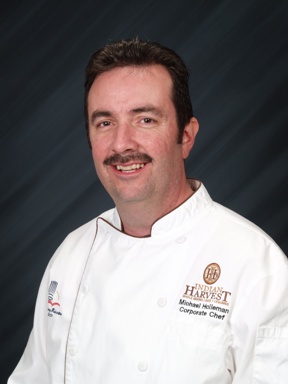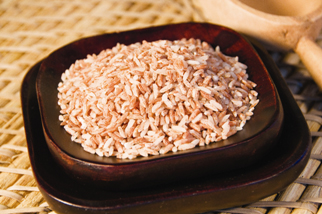Sustainable, Defined
31 May 2009By Brent T. Frei
 Michael Holleman gets to the bottom of a top-of-mind foodservice issue.
Michael Holleman gets to the bottom of a top-of-mind foodservice issue.
“Sustainable” is one of the hottest buzzwords in the foodservice industry today. Yet, ask 10 people to explain what sustainable food production means, and get 10 different responses. At least one supplier has defined the term, the result of maintaining a business model that has remained virtually unchanged for more than 30 years.
Michael Holleman, corporate chef of Bemidji, Minn.-based Indian Harvest, Inc., a niche supplier of rice and rice blends, exotic grains and legumes to foodservice, believes that diners today are looking for more than food. They want an event. “It has to be something special: stunning plate presentation, culinary adventure, distinct pairing,” he says.
He also believes diners hanker for a story behind the food that brings the experience to life, evidenced by unprecedented interest in foods’ origins before they land on the plate. That’s why Indian Harvest grains and grain blends are borne of a passion that extends from farm to fork.
Holleman began his culinary career in independent restaurants, where his interest in specialty and heirloom ingredients was born. Now working in the supply side of the industry, he’s free to indulge his passion as he seeks unusual varieties of grains and rice the world over, and hand-selects seeds for experimental cultivation.
Founded in 1978 from humble beginnings as a family-owned company dedicated to cultivating and processing wild rice from northern Minnesota wetlands, Indian Harvest was an early pioneer in the sustainable-food movement. To the company, “sustainable” describes a commitment to preserving the environment and ensuring humane treatment of workers and work animals while guaranteeing a safe, renewable food supply.
“Indian Harvest uses the term ‘sustainable’ very simply,” Holleman says. “It’s a practice that can be continued over time without detriment to those and that which it affects. That simple answer permeates every aspect of how we operate.”
Sustainability Starts with People
Indian Harvest employs approximately 100 people at peak season at its operations in Minnesota and Colusa, Calif. “We value highly the contributions of all of our workers, many of whom are seasonal and return year after year,” Holleman says. “This extends to all of our business relationships, foreign and domestic. Our core values are to treat everyone we encounter with dignity and respect.”
To consistently offer unique products to customers, that often means sourcing internationally. “When we source a product from overseas, it’s no different from at home,” Holleman says. “We don’t buy commodity; instead, we have relationships with farmers and growers, and oftentimes we work with them well before crops are planted, creating contracts that not only serve Indian Harvest customers, but also the needs of the farm and soil, ensuring sustainability for the farmer and the farm.”
A living example of this philosophy lies in the rugged mountains of the Philippine island of Luzon, which has been called the Eighth Wonder of the World: the Philippine Rice Terraces, carved out of the hillside by Ifugao tribe people millennia ago without the aid of machinery. Stretching for nearly 4,000 square miles, crops are fed by an ancient irrigation system from the rainforests high above the terraces.
From this unique place on earth comes several Fair-Trade-grown heirloom rice varieties distributed by Eighth Wonder, a company dedicated to preserving Filipino rice farmers’ traditional way of life. As the exclusive foodservice distributor of Eighth Wonder rices to North America, Indian Harvest offers Kalinga Unoy, Tinawon Fancy and Ulikan Red, the most-common varieties grown on the Luzon terraces, through its new Indian Harvest Boutique line.
“There are many stories about the Luzon farmers making more money from one transaction than they’ve seen after many years of toiling to eke out a meager existence,” Holleman says. “Indian Harvest is fortunate to have the opportunity to work with a company like Eighth Wonder that is bringing hope to a corner of the world where hope was previously in short supply.”
 Certified Organic: Good, but Sustainable’s Better
Certified Organic: Good, but Sustainable’s Better
Although many of Indian Harvest’s products are organically grown, the company doesn’t process them organically because the energy and expense involved do not yield a practical benefit. The products are sustainable nonetheless.
“By purchasing organically grown ingredients whenever possible we support organic practices, which are good for the earth and good for the people cultivating and eating the crops,” Holleman says. “By processing as efficiently as possible, we are providing an excellent product to our customers without passing on the unnecessary expense and energy consumption of conforming to organic-processing regulations.” To illustrate, Holleman cites a complete and total evacuation of the processing plant whenever a non-certified organic product is introduced into the plant.
Adds Holleman, organic certification is very expensive to maintain and can be easily endangered by neighboring crops and other factors not under the grower’s control. “If we required organic certification on every product we used, we would have to have multiple growers to ensure we have enough product,” he says. “Certified organic is good, but the spirit of sustainability, we feel, is better.”
Preserving and Promoting Heirloom Crops
Indian Harvest has a decades-long heritage of working with seed banks and using heirloom seeds. Heirloom seeds are seeds that have been preserved—unadulterated by modern breeding. They were commonly grown during earlier periods in human history, but not used in modern large-scale agriculture. By sourcing heirloom seeds, Indian Harvest does its part in promoting agridiversity in the commercial market, bringing a small number of customers a tastier, more nutritious product and, ironically, a new experience for the diner.
“Often, we’re talking about literally a handful of seeds, as few as 20 or 30, so growing them to maturity for evaluation is a time-consuming process,” Holleman says. “You never know what you’re going to get. It can take a number of years to get a commercially viable quantity, or even enough to cook up!”
How is this sustainable? “The world needs to keep the number of plant species as high and diverse as possible,” Holleman says. “Natural cross-breeding can occur with neighboring crops, and requires special care by the farmer to remain a good neighbor. We know the growers we work with respect the crop, respect the earth and respect their neighbors. In return, we sustain each other as business partners.”
Enviro-friendly Processing and “Buying Local”
While the grains that Indian Harvests supplies are not required to conform to the same food-safety standards as regular packaged goods, the company holds its entire product line to these standards and beyond. Using state-of-the-art equipment and completely natural methods, grains are meticulously sorted by weight, color and size, removing foreign particles and even broken kernels. Then in cases where product is parboiled or scarified to unify cook times for convenience, Indian Harvest uses the purest ingredient there is—water—to accomplish these tasks. “This is sustainable because it’s efficient at a large scale, it’s pure and natural, and it yields a purer product to the end user,” Holleman says. “It costs a little more, but it’s a sustainable business practice that supports every point of the value chain, right down to the diner.”
As many U.S. foodservice opera tions begin to suffer from what is sometimes described “green fatigue”—the onslaught of environmental news affecting restaurants and what operators should do to lessen their carbon footprints, much of it cost-prohibitive—“buying local” is the new catchphrase sweeping the industry. But purchasing only foods grown in the community would yield very limited menus, and thus isn’t realistic.
tions begin to suffer from what is sometimes described “green fatigue”—the onslaught of environmental news affecting restaurants and what operators should do to lessen their carbon footprints, much of it cost-prohibitive—“buying local” is the new catchphrase sweeping the industry. But purchasing only foods grown in the community would yield very limited menus, and thus isn’t realistic.
Yet chefs and operators can still jump on the buy-local bandwagon and please their customers, more of whom are demanding to know where their foods come from.
“Much like wine grapes, grains don’t grow in every region, and they require processing that can’t always be done on or near-site,” Holleman says. “So, to Indian Harvest, ‘local’ comes to mean an understanding of the region or area where the grain is grown and the circumstance under which it came to be on the plate. This makes it real to the customer, and for that reason we recommend that establishments menu rices and grains as they might Kobe beef, heirloom tomatoes from the local farmers’ market or a Napa Valley wine. Your Colusari Red Rice may not have come from down the street, but it did come from a seed bank 20 years ago, and has been grown by the same grower in the fertile Sacramento Valley over those decades to bring you this unique variety that you can’t get anywhere else.”
Additional Info
- CAFÉ Talks Podcast Lesson Plan: 2
